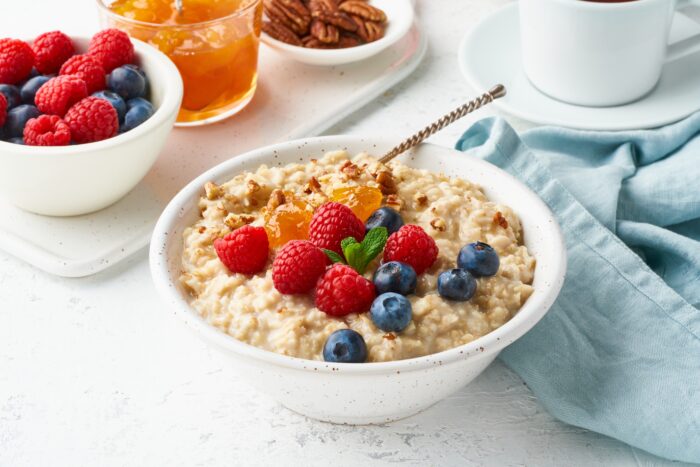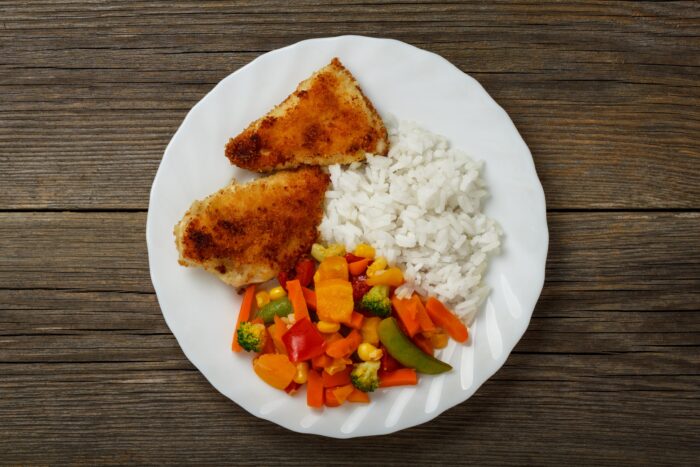By Erin Dougherty, a clinical dietitian at CHOC
Preparing your teen to eat healthy in college helps them develop lasting habits and make smart food choices during this exciting transition.
College is an incredible milestone and exciting time of change. Teaching your teen how to make healthy choices and fuel their body is a key skill that can help your child be successful during this transition.
Talk about nutrition and cooking skills early on
This article discusses tips and tricks for navigating healthy eating in college, but you should try to introduce these topics long before college comes along. One area to start developing early on is kitchen basics and cooking confidence:
- Encouraging independence and exploration in the kitchen
- Have your child practice mixing, chopping, and following a recipe alongside you
- Teach them how to navigate the grocery store and create a grocery list
- Have them practice easy recipes (ideas below)

Teach your teen how to navigate a grocery store
- Create a grocery list
- Determine the amount of food your teen will need for the week
- Does your teen plan on eating snacks and breakfast at home and eating lunch and dinner at the dining hall? Do they plan on cooking most meals?
- Plan out meal ideas for the week
- Write down all the ingredients needed
- Organize the list based on the areas of the grocery store
- Determine the amount of food your teen will need for the week
- Start by shopping the perimeter of the grocery store to grab produce first
- Then, go into the aisles to pick up dry goods
Discuss what their college meal plan will look like
Everyone’s journey through college looks different. Some common living arrangements for college students include:
- On-campus housing or in a dorm
- Off-campus housing or in an apartment
- Living at home and commuting to school or taking classes online
Living in a dorm room likely means that your child will be getting most of their food from a dining hall and may not have access to a kitchen. In this case you will want to help them make a plan for what snacks to have available in their room or stocked in a mini-fridge. If your child will be in an apartment or at home, they likely will have access to a kitchen and will be preparing more items for themselves. Whatever the case may be, it’s important to discuss what their food access will look like.
How to navigate a dining hall
The dining hall is an exciting place with many different options. It creates a great opportunity to easily build a balanced plate. The dining hall could also create a challenge for portion sizes if it follows a buffet style model. Here are some tips for navigating the dining hall:
- Read the dining hall’s menu online and see what looks good
- Take a lap around the dining hall and check out all the options before picking up a plate or tray
- Visit the salad bar or fruit and vegetable stations first and fill about half the plate with these items
- Be mindful of hunger and fullness cues
All about snacks
Going to college may involve increased amounts of movement (walking to class, participating in intramural sports, exploring a new community) and your child is using their brain to its maximum capacity. All of this means that they especially need to make sure they are properly fueled.
It’s important to plan for moments when the dining hall may be far away, or your child has back-to-back classes and doesn’t have time to pick up anything.
Here are some recommendations for on-the-go, backpack-friendly snacks:
- Trail mix – rich with healthy fats and omega-3s for brain health
- Jerky – a protein item that can keep your child full for longer
- Peanut butter or hummus with pretzels – a combination of healthy fats and carbohydrate which means greater ability to satisfy hunger

Ideas for stocking a mini fridge:
Some college students enjoy having a mini fridge in their room for access to snacks and supplies for easy, simple meals. Here are some ideas for what to stock in a mini fridge:
- Fruits and vegetables
- Pick items that are pre-washed and cut for ease
- Vegetables: carrots, snap peas, bell pepper, jicama
- Fruit ideas: apples, berries, strawberries
- Protein:
- Low-sodium lunch meat slices
- Edamame
- Tofu
- Dairy:
- Milk
- Cheese slices or cheese sticks
- Yogurt cups
- Dips and other miscellaneous snacks:
- Hummus
- Ranch
- Tzatziki
Recipe ideas: microwave-friendly meals

Nut Butter and Berry Oatmeal
Supplies:
- Microwaveable bowl
- Spoon
- ½ cup measuring cup
Ingredients:
- ½ cup oats
- ½ cup milk or water
- 1 tbsp chia seeds
- 1-2 tbsp peanut butter
- ½ cup frozen or fresh fruit (berries are a good option)
Instructions:
- Place the oats, and chia seeds in a microwavable bowl and cover with milk (or water)
- Microwave on high for 1 min 30 seconds
- Mix well, if the oats are too thin microwave for 30 seconds more. If too thick add more milk or water
- Add in peanut butter and top with berries
- Enjoy!
Recipe source: Erin Dougherty, a clinical dietitian at CHOC

Minute Rice with Vegetables and Chicken
Supplies:
- Microwaveable Bowl
- Spoon
Ingredients:
- 1 Minute-rice rice cup
- 1 cup frozen mixed vegetables
- 4 oz frozen grilled chicken (example: Tyson Grilled & Ready Chicken Breast Strips)
- 1-2 tbsp soy sauce
- Optional: siracha
Directions:
- Cook Minute-Rice according to package instructions and set aside
- In your microwavable bowl, add 1 cup frozen vegetables, 1 tsp water, and 4 oz of frozen grilled chicken and cover with paper towel. Microwave for 1 minute 30 seconds.
- Pull out of microwave once done cooking and check to ensure everything is warmed through
- Combine Rice, vegetables, and chicken. Top with soy sauce and enjoy!
Recipe source: Minute Rice Microwave Fried Rice
Get more expert health advice delivered to your inbox monthly by subscribing to the KidsHealth newsletter here.
Learn more about CHOC’s Clinical Nutrition Program
At CHOC, we specialize in providing a full continuum of pediatric nutrition services, including inpatient and outpatient services, depending on our patients’ needs.





